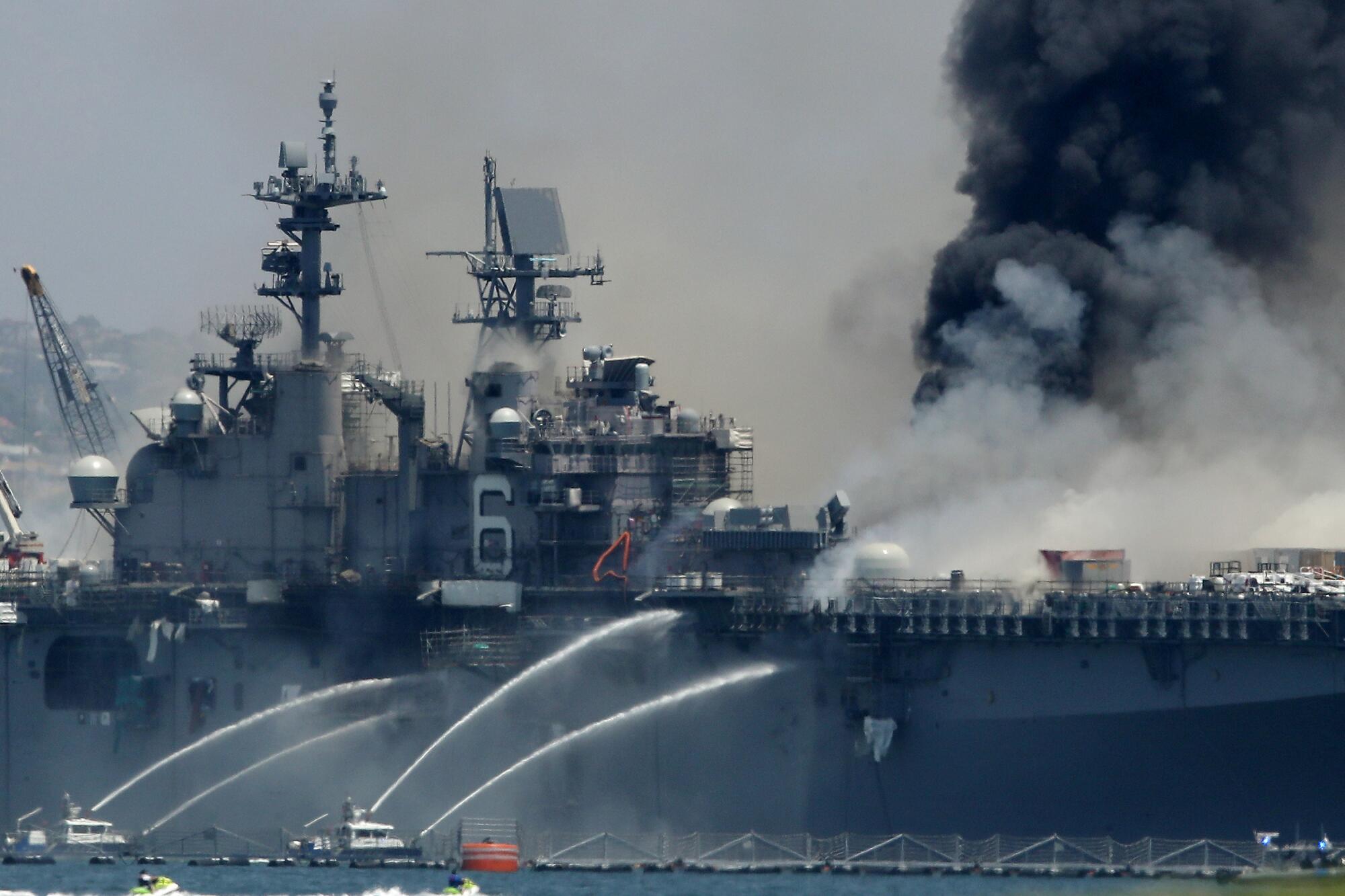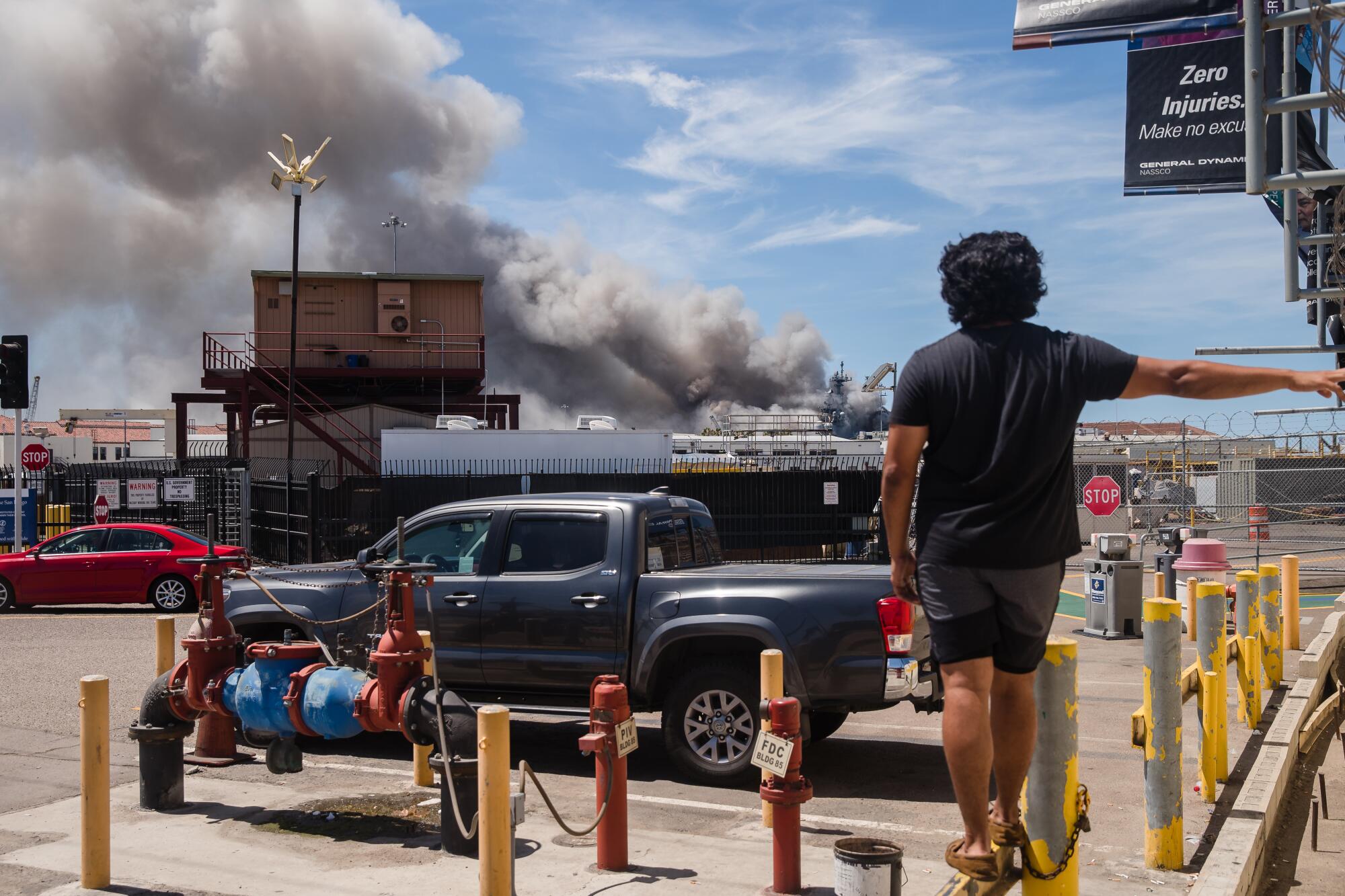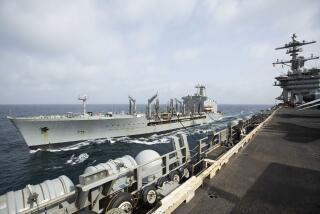
The cause of the three-alarm blaze and the extent of damage were not known as of Sunday night.
- Share via
SAN DIEGO — Navy and fire crews this morning are still trying to put out a massive fire on board the amphibious assault ship Bonhomme Richard at San Diego Naval Base.
As of 6:30 a.m., fire fighting teams continued to battle. The Navy said 57 sailors and civilian personnel aboard the ship had been treated for minor injuries, including heat exhaustion and smoke inhalation; of those five remain hospitalized and are in stable condition.
The fire had blazed throughout the day, causing massive smoke plumes throughout the region into Sunday evening.
The cause of the three-alarm blaze and the extent of damage were not known Sunday night, but Rear Adm. Philip Sobeck, commander of Expeditionary Strike Group 3, said the Navy believes the fire began in a lower cargo hold, a deep V area, where marine equipment and vehicles are stored.
In total, about 1,000 sailors are assigned to the ship; 160 sailors were aboard Sunday morning. They were evacuated from the ship, the Navy said.

The fire was reported shortly after 8:50 a.m., according to San Diego Fire-Rescue officials. Witnesses reported hearing an explosion. Throughout the day, fumes and smoke that turned black, gray and white billowed from the ship.
The city of National City issued an advisory around 2:30 p.m. urging residents to stay indoors due to potential health effects of the smoke plume. One National City business only allowed to operate outdoors due to COVID-19 public health orders — Machete Beer House — announced on Instagram it was closed for the day due to the plume.
The San Diego County Air Pollution Control District issued an advisory: “In areas where you smell smoke it is advised that you limit physical activity. If possible, stay indoors to limit your exposure to fine particulate matter.”
Sobeck said the fire was not fueled by fuel oil, hazardous materials or electrical causes. It is a Class Alpha fire, he said, meaning it was fueled by paper, cloth, rags or other materials in a standard fire. He added he is not concerned about the air quality or toxicity around the fire.
Sobeck said there was no ordnance on board. There are a million gallons of fuel on board, he said, but that is “well below” any heat source.
The explosion people heard in the morning was likely caused by a change in air pressure, he said.
Earlier at least a dozen fire engines and trucks were near the pier, with at least six ambulances staged inside. The fire department said at the time that 150 firefighters were assigned to the blaze and a fire investigator was dispatched.
Also all Navy ships in port in San Diego were directed to provide fire parties to assist in firefighting efforts, according to Mike Raney, a Navy spokesman.
Two other ships, guided-missile destroyers Fitzgerald and Russell, were moored near the Bonhomme Richard but were moved early Sunday afternoon to berths farther away from the burning vessel.
Federal Fire San Diego Division Chief Rob Bondurant said in a statement around 4:15 p.m. that two teams were still fighting the blaze on the ship.
“Federal Fire is rotating their crews aboard the ship with U.S. Navy firefighting crews from the waterfront to fight the fire in order to find the seat of the fire and extinguish it,” Bondurant said. “Also, Navy Region Southwest tugs are also continuously combating the fire from the bay.”
By Sunday evening, significant progress was made, Sobeck said. Sailors were fighting the fire inside the ship, he said, putting fire fighting agents directly onto the fire.
He said all sailors are trained in boot camp how to fight fires.
“The sailors across this waterfront are absolutely doing a magnificent job,” he said. “They are fighting their ship and saving their ship.”
He said he didn’t know the extent of damage yet, but he anticipates the Navy would repair the ship.
“We’re absolutely going to make sure it sails again,” Sobeck.
Meanwhile, warnings about air quality and safety issues persisted into the early evening, as fire crews continued spraying water on the smoking ship.
A shelter-in-place order alert went out around 5:30 p.m. asking all personnel who are not first responders but who are on the wet-side of north of Pier 5 to take shelter until further notice. The Navy also was not letting any watercraft beyond the San Diego-Coronado Bay Bridge.
Sobeck said the Navy was just trying to put a perimeter around the fire.
“It’s an ashy fire; there’s nothing toxic in there,” Sobeck said.

A three-alarm fire onboard the amphibious assault ship Bonhomme Richard injured 17 sailors, four civilians Sunday morning as multiple agencies responded to the blaze, which been burning since just before 9 a.m.
Earlier in the day, San Diego Fire Chief Colin Stowell said via text that the Navy would have a strategy and plan to fight the fire, and told CNN that the ship could burn for days.
Stowell wrote that it is very difficult to get access and make an “offensive attack on a fire below deck.”
“Heat cannot ventilate out,” Stowell wrote. “(There are a) lot of dynamics with a ship fire, different from a structure fire.”
The ship was in drydock at General Dynamics NASSCO in San Diego last year and has been undergoing further maintenance pierside at San Diego Naval Base. Its last deployment was in 2018.

Amphibious assault ships are used to deploy Marines in amphibious landings. During operations, the ships conduct flight operations with helicopters and jet aircraft, such as the AV-8B Harrier and its replacement, the F-35 B Lightning.
While deployed, these ships carry more than 2,000 sailors and Marines.
Eric A. Dukat, a retired Navy commander who is now an associate professor in the College of Maritime Operational Warfare at the U.S. Naval War College, told The New York Times that sailors are thoroughly equipped to handle fires on ships.

“Everyone gets trained to be a firefighter, flooding stopper — all the damage control — and that’s because when you’re out at sea, there’s nobody coming to you,” he said.
Dukat, who worked as a damage control assistant aboard the Wasp, said fires on ships present a unique hazard because of the rising heat inside the vessel and the intense steam that’s produced when water is used.
In 1967, a fire on the aircraft carrier Forrestal killed more than 130 sailors after a rocket accidentally fired on the flight deck and ignited several explosions. The episode has been used as a lesson on how to tackle safety procedures aboard Navy vessels, Dukat said.
The George Washington, a nuclear-powered aircraft carrier, caught fire in 2008 when oil was improperly stored on the craft. At least 37 sailors were injured in the fire that took 12 hours to put out and cost $70 million in repairs.
Union-Tribune photojournalist Sam Hodgson and reporter Karen Pearlman contributed to this report.
More to Read
Sign up for Essential California
The most important California stories and recommendations in your inbox every morning.
You may occasionally receive promotional content from the Los Angeles Times.









